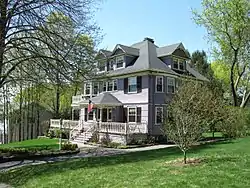House at 9 White Avenue | |
 House at 9 White Avenue | |
  | |
| Location | 9 White Ave., Wakefield, Massachusetts |
|---|---|
| Coordinates | 42°30′42″N 71°4′17″W / 42.51167°N 71.07139°W |
| Area | less than one acre |
| Built | 1903 |
| Architectural style | Colonial Revival, Georgian Revival |
| MPS | Wakefield MRA |
| NRHP reference No. | 89000677 [1] |
| Added to NRHP | July 06, 1989 |
The House at 9 White Avenue in Wakefield, Massachusetts is a well-preserved transitional Queen Anne/Colonial Revival house. Built about 1903, it was listed on the National Register of Historic Places in 1989.[1]
Description and history
White Avenue is located northeast of downtown Wakefield, and is a short street in a residential area just east of Lake Quannapowitt. This house stands on the north side of the street, facing south on a lot that slopes west toward the lake. It is a 2+1⁄2-story wood-frame structure, with a hip roof, with two gable-roof and clapboarded exterior. Its roof has dormers bracketing an oriel window in front, and a normal gabled dormer to the side; these gables are decorated with jigsawn Queen Anne woodwork. The house is three bays wide, with a center entrance sheltered by a porch supported by paired columns, with jigsawn valances. The porch extends to an open veranda to either side.[2]
White Avenue was originally part of a larger property owned by John Aborn, a shoemaker who lived in a house west of this one on Main Street. Aborn and his father-in-law John White owned a successful shoe factory. Aborn's heirs laid out White Avenue and adjacent Aborn Street in 1857, and the area was developed in the 1860s and 1870s as a residential area for local middle-class businessmen and tradesmen.[3] This house was built about 1903, and its first long-term owner was Edward Gleason, who moved here from Aborn Street. Gleason was a prominent local landscape and portrait photographer, who also kept an office in Boston. Gleason is credited with most of the photographs depicted in the 1893 book Wakefield; its Representative Business Men and Points of Interest.[2]
See also
References
- 1 2 "National Register Information System". National Register of Historic Places. National Park Service. April 15, 2008.
- 1 2 "NRHP nomination for House at 9 White Avenue". Commonwealth of Massachusetts. Retrieved 2014-02-11.
- ↑ "NRHP nomination for House at 18A and 20 Aborn Street". Commonwealth of Massachusetts. Retrieved 2014-02-01.
